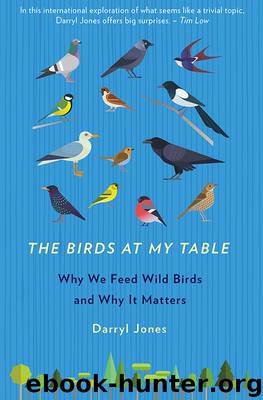The Birds at my Table by Darryl Jones

Author:Darryl Jones
Language: eng
Format: epub
Publisher: NewSouth
Published: 2018-01-10T05:00:00+00:00
Changes in Behavior
To conclude this selective review of supplementary feeding experiments on tits and chickadees, we turn to the possible influences on perhaps the most malleable and immediate features of their lives, their behavior. It is one thing to measure physical attributes such as egg size and body mass; it’s a very different matter to ask questions about what the birds are actually doing in response to the additional food.
Given the importance of food to the day-to-day survival of these small birds, particularly during tough conditions, it would hardly be surprising to find feeding can change their social interactions. Although an obviously social group, spending almost all their time in loose groups, tits and chickadees tend to forage alone when seeking their natural diet of insects and seeds. They may be close to the rest of their flock, but the type of food they glean means that it is best obtained without the interference of other birds. During periods of natural food abundance, when there is little competition between individuals, the birds are fairly tolerant of one another’s presence. As conditions become more difficult, as occurs with the start of cooler weather, relationships often become less amicable. Wilson looked at such interactions among her Black-capped Chickadees during the harsh winters in Maine when feeders were experimentally introduced.42 In natural situations, the onset of cold conditions led to increasingly more assertive behaviors by individuals with smaller foraging areas being defended against other chickadees. These patches were established throughout the site, with each bird actively patrolling what was now a small but private “foraging territory.” Trespassing was strictly policed, each bird the master of its own modest domain.
The introduction of feeders abruptly changed all that. With the sudden arrival of a super-abundant food bonanza at just a few localized spots, the former system of territorial enforcement broke down entirely. For the birds living close to the feeders, whatever perceptions of outrageous good fortune they may have had soon dissolved in the reality of the inevitable influx of all and sundry to the feeder. Although many of the birds initially attempted to maintain their boundaries, the constant crossing by birds drawn to the feeders soon led to territoriality being given up completely. For these small birds, there was simply no way that an individual could successfully defend “their” feeder. In other situations (discussed elsewhere in this book), usually where the species are much larger and more capable of effective defense, the introduction of feeders can lead to a serious esca-lation of territorial behavior.
Another influence of supplementary foods on foraging behavior relates to joining feeding flocks made up of different species. While it is generally rare for most birds to deliberately seek the company of other species, the formation of groups of similarly sized birds of a variety of species has been reported from around the world. These flocks are temporary and are usually made up of groups of insectivorous species that occur together in the same woodland or forest habitat. Although there is
Download
This site does not store any files on its server. We only index and link to content provided by other sites. Please contact the content providers to delete copyright contents if any and email us, we'll remove relevant links or contents immediately.
Photographic Guide to the Birds of Indonesia by Strange Morten;(2469)
The Big Twitch by Sean Dooley(2369)
7-14 Days by Noah Waters(2298)
Tippi by Tippi Hedren(2156)
Identifying Birds by Colour by Norman Arlott(2149)
Birds of the Pacific Northwest by Shewey John; Blount Tim;(1906)
Raptors by Traer Scott(1558)
The Path Between the Seas by David McCullough(1548)
Bald Eagles In the Wild by Jeffrey Rich(1440)
Life on Earth by David Attenborough(1400)
Skin by Unknown(1345)
How to Speak Chicken by Melissa Caughey(1281)
Nest by Janine Burke(1236)
The Feather Thief by Kirk Wallace Johnson(1221)
Life List by Olivia Gentile(1148)
H Is for Hawk by Helen Macdonald(1143)
Birds of New York City by Cal Vornberger(1142)
RSPB Pocket Guide to British Birds by Simon Harrap(1120)
The Peregrine by J. A. Baker(1076)
